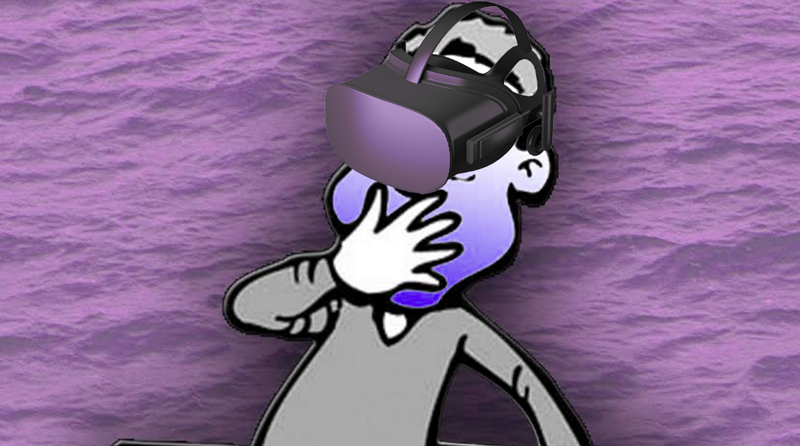Are you susceptible to motion sickness, such as air sickness or sea sickness? Many of us are, but a new kind of sickness is making its way literally into our homes, and it’s called virtual reality sickness or cybersickness. What is it, how can we deal with it, and can this new product from a startup company help us fight it?
2016 is being called the Year of Virtual Reality, but the reality is that it is causing a lot of problems for users. Virtual reality sickness is that nauseous feeling you get when you’re viewing VR content. Our brains are essentially being told that our body is in motion when it’s not. So, it gets confused and disoriented, causing the nausea. So how do we deal with it?
Believe me, Dramamine is not the solution you’re looking for. Though it’s been used for years to treat motion sickness, it is not a practical answer for virtual reality sickness.
“Users who abuse this drug have side effects that show as poisonings of the muscarinic acetylcholine receptors in the nervous system, which in turn inhibits signal or nerve paths. Visual and auditory hallucinations are common, causing confusion and even short-term memory loss as well as paranoia among users. The higher the dose taken, the worse and more realistic the hallucinations become. It is common among abusers to hear their name being called and see creatures that invoke fear, or to have conversations with someone who is not present.”
So basically, using dramamine indiscriminately could make you create a virtual reality world of your own – not ideal!
How is Virtual Reality Sickness Caused?
David Whittinghill, an associate professor of computer graphics technology and computer information technology in Purdue’s Polytechnic Institute, explains what causes virtual reality sickness:
“Motion-to-photon latency, which is the time it takes for you to turn your head and the screen to refresh at the same rate, is one of the main culprits of VR sickness. If latency is present then the photons that represent the scene strike your retina out of sync with your head’s motion. This lag causes your body to react negatively, inducing vertigo and sometimes nausea.”
In simple terms, this means your eyes aren’t getting the signs of movement at the same time as when your head moves. But that’s just one of the reasons. Whittinghill continues:
“Another factor is dissonance between the inputs received by the vestibular and visual systems. We call motion in virtual spaces vection. Vection is when your body moves forward and backward, left and right, or up and down, as opposed to rotating in a fixed position. The VR developer community has put forth a set of app design principles that recommends users primarily rotate in the virtual space rather than allow free vection. Discouraging vection reduces the degree of dissonance between the ocular and visual systems, and thus helps avoid simulator sickness.”
This rotation in virtual space is very similar to what we experience on several amusement park rides. If you’re one of those people – like me – who hate these rides, then virtual reality could be a major problem for you. But, surprisingly, even those who love theme park rides are apparently experiencing VR sickness. Whittinghill goes on:
“We were all very excited to try our brand new VR headset. However, we were extremely disappointed to find that we all got fairly sick when we tried out pretty much anything with it. It really surprised me, in particular, because I like theme park rides and I generally have a pretty high tolerance for motion sickness. I didn’t expect to have such an immediate response. It was really intense.”
What’s their Solution for Virtual Reality Sickness?
As a result, Whitinghill and his team of students experimented with several ideas, and finally settled on one that they tested – a virtual nose called nasum virtualis.
What is Nasum Virtualis? It basically acts as a reference point when you’re inside the VR experience. Incidentally, having a fixed reference point does reduce the motion sickness that you experience even in the physical world. The team got the idea from animals. Most predatory animals have their noses or snouts or beaks in front of them – visible. By adapting this concept, Whittinghill’s team successfully showed that introducing a “virtual nose” into the VR experience can greatly reduce the chance of VR sickness.
“We observed a 13.5 percent drop in severity of sickness and an increase of time in the simulator, just by adding a simple component that doesn’t interfere with the game and is computationally very cheap.”
The virtual reality nose is now patented through the Purdue Office of Technology Commercialization and currently available for license, and the company itself is called Virtualis LLC.
Whittinghill hopes that VR headset makes will start adopting the new technology so more people can enjoy the VR experience without having to worry about VR sickness. But this isn’t the only solution they’re creating. They’re currently pursuing even more options to fight VR sickness because they realize that this solution may not work for everyone.
The company is currently seeking additional funding for ongoing research and expanding their team so they can move faster and come up with more virtual reality sickness solutions like the Nasum Virtualis.
There are also several other solutions from other companies for VR sickness, such as vMocion, which uses the Mayo Clinic’s Galvanic Vestibular Stimulation (GVS) technology to trick the brain into syncing its vestibular and visual systems.
In addition, FreeFlyVR has a list of things you can do to reduce virtual reality sickness or cybersickness.
Thanks for reading our work! Please bookmark 1redDrop.com to keep tabs on the hottest, most happening tech and business news from around the world. On Apple News, please favorite the 1redDrop channel to get us in your news feed.




